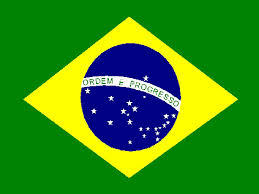
Beatriz Ilari
Patrick Schmidt
Nation/Culture(s). Brazil is the largest country in South America, and the most populous Portuguese speaking country in the world. It borders all South American countries, except for Chile and Ecuador. The population of Brazil is estimated at 191 million inhabitants, with the majority living in the coastal areas. According to a national survey conducted in 2008, about 48% of Brazilians consider themselves to be white, 43% define themselves as mestiços (mixed-race), and smaller numbers see themselves as blacks, Amerindians, or Asians. Most Brazilians are Roman Catholics, yet there are growing numbers of other religious denominations in the country.
Brazil is known for its cultural hybridism. Amerindian, European, and African cultures have given origin to a cultural mosaic that is revealed in Brazil’s music, dance, food, and way of life.
Music. Features, Genres (Art, Folk/Traditional, Popular)
Brazil has a strong musical tradition that spreads throughout several genres. From early colonial times to the mid-nineteenth century, art music has been marked by European influence (mostly Portuguese, Italian, and French), followed by nationalist currents that coincided with the fall of the monarchy and a marked cosmopolitanism after World War II. Jose Mauricio Nunes Garcia (1767-1830) was the first Brazilian composer to achieve some international recognition, followed by Antonio Carlos Gomes (1836-1896), Brazil’s most prolific opera composer. Born in Rio de Janeiro, Heitor Villa-Lobos (1887-1959) is arguably the most significant Latin-American composer. The recent growth in Brazilian economy has helped to consolidate orchestras particularly in large urban and cultural centers such as São Paulo and Rio de Janeiro.
Brazilian regional and folkloric music is extremely rich and varies significantly according to geographic location. A country of dance, Brazil is well known for its many dance-forms and inventive, intricate rhythms such as jongo, maracatu, afoxé, forró, and other hybrid forms. Another well known cultural manifestation that involves music is capoeira, a dance/martial arts genre, which is played all over the world.
After Carmen Miranda’s success in the 1940s, Brazilian popular music became a global phenomenon. Other Brazilian styles and genres were exported throughout the 20th century as well. Although Bossa Nova and Samba, often taken as token representations of Brazilian musical culture, are household terms in many parts of the world, they are simply a minute expression of a wide socio-cultural manifestation. Other important styles/genres worth mentioning are: Choro, MPB (Brazilian popular music), Pagode, Sertanejo, Musica Gaucha, Samba-Reggae, Jongo, Tambor de Crioula, as well as Brazilian Funk and Rap. All of these categories are somewhat arbitrary and hold within them many subdivisions.
Notable Musicians.
Heitor Villa-Lobos
Mozart Camargo Guarnieri
Francisco Mignone
José Maurício Nunes Garcia
Antonio Carlos Gomes
Ary Barroso
Carmen Miranda
Tom Jobim
João Gilberto
Chico Buarque de Hollanda
Caetano Veloso
Gilberto Gil
Milton Nascimento
Elis Regina
Music in Higher Education. Tertiary music programs in Brazil are quite recent if compared to some other parts of the world, and there are programs being developed as we speak. Although there are some private institutions that offer undergraduate and graduate programs in music, the vast majority of programs that exist in the country are public and completely tuition-free. Programs vary immensely in their offerings, yet all follow the strict regulations of Brazil’s Ministry of Education. Music research exists almost exclusively in public universities which are funded by the federal government or states. The Associação Nacional de Pesquisa e Pós-Graduação em Música (ANPPOM) is the main forum for dissemination of music research in Brazil through its annual conferences and the journal “Opus” (http://www.anppom.com.br/opus/). Brazil’s two main funding agencies, CNPq and CAPES, offer opportunities for North American researchers to collaborate with Brazilian institutions. These can be viewed at (www.cnpq.br) and (www.capes.gov.br).
Music in Schools. Music education remains a challenge in Brazil, but also demonstrates the manner in which organizations can have significant impact in providing access and equity. While Brazilian music education could be said to have been systematically established by a campaign headed by Heitor Villa Lobos in the early part of 20th century—focused on singing and Canto Orfeonico—music in schools has experienced many ups and downs. In many ways Brazilian music education follows international trends, with performance-based choral, orchestral and band ensembles. Regionalism has remained an important influence over the years—military bands, for instance, were and continue to be an important element in the Northeast.
Legislation in 1992 and 2008 impacted music education by instituting it as part of arts education. It provided access to school music, but was subsumed under an Arts umbrella. A wide advocacy coalition encompassing artists, industry, and ABEM (National Brazilian Association of Music Education) was instrumental in approving the 2008 legislation which established music as an obligatory subject in schools. Regardless of implementation challenges, this new law stirred growth, impacting both teacher education programs as well as music in state and municipal schools across the nation.
It is important to note that Brazil also contains a wide network of community centers and schools, often led by non-governmental organizations, who provide musical instruction and musical interaction to a wide swath of the Brazilian populace.
Contacts.
Liane Hentschke
Magali Kleber
Sergio Figueiredo
(all three held positions as presidents of ABEM).
Recommendations for Listening.
For an excellent discography of Brazilian recording artists across many genres see the following site:
http://library.columbia.edu/indiv/global/latam/guides/bwmd.html
Recommendations for Viewing.
Brasileirinho (Mika Kaurismaki)
Moro no Brasil (Mika Kaurismaki)
BBC documentaries
O povo brasileiro – documentary
Recommendations for Reading.
O que faz o Brasil, Brasil? DaMatta, R. (2001). Rio de Janeiro: Rocco.
Hello, Hello Brazil: Popular Music and the Making of Modern Brazil. Durham, Bryan McCann (2004).Duke University Press.
Music in Brazil: Experiencing Music, Expressing Culture. Murphy, John P. (2006).New York: Oxford University Press.
História Social da Música Popular Brasileira. Tinhorão, José Ramos. Rio de Janeiro.
The Music of Brazil. Appleby, David. Austin: UT Press.

